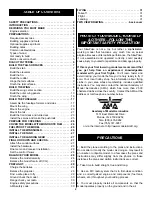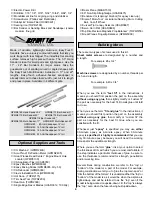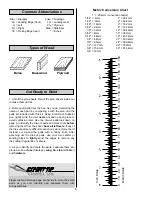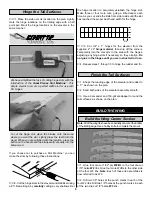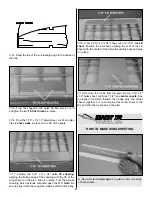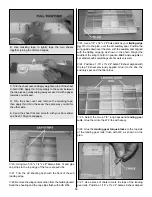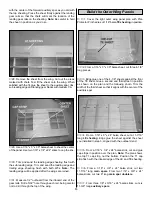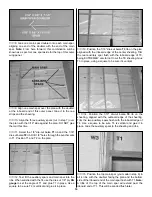
SAFETY PRECAUTIONS. . . . . . . . . . . . . . . . . . . . . . . . 2
INTRODUCTION . . . . . . . . . . . . . . . . . . . . . . . . . . . . . . 3
DECISIONS YOU MUST MAKE . . . . . . . . . . . . . . . . . . 3
Engine selection . . . . . . . . . . . . . . . . . . . . . . . . . . . . . . 3
PREPARATIONS . . . . . . . . . . . . . . . . . . . . . . . . . . . . . . 3
Required accessories . . . . . . . . . . . . . . . . . . . . . . . . . . 3
Building supplies and tools . . . . . . . . . . . . . . . . . . . . . . 3
Optional supplies and tools . . . . . . . . . . . . . . . . . . . . . . 4
Building notes . . . . . . . . . . . . . . . . . . . . . . . . . . . . . . . . 4
Common abbreviations . . . . . . . . . . . . . . . . . . . . . . . . . 5
Types of wood. . . . . . . . . . . . . . . . . . . . . . . . . . . . . . . . 5
Get ready to build . . . . . . . . . . . . . . . . . . . . . . . . . . . . . 5
Metric conversion chart . . . . . . . . . . . . . . . . . . . . . . . . . 5
DIE-CUT PATTERNS . . . . . . . . . . . . . . . . . . . . . . . . . . . 6
BUILD THE TAIL SURFACES . . . . . . . . . . . . . . . . . . . . 7
Build the stab . . . . . . . . . . . . . . . . . . . . . . . . . . . . . . . . 7
Build the elevators. . . . . . . . . . . . . . . . . . . . . . . . . . . . . 7
Build the fin . . . . . . . . . . . . . . . . . . . . . . . . . . . . . . . . . . 8
Build the rudder. . . . . . . . . . . . . . . . . . . . . . . . . . . . . . . 8
Hinge the tail surfaces. . . . . . . . . . . . . . . . . . . . . . . . . . 9
Finish the tail surfaces. . . . . . . . . . . . . . . . . . . . . . . . . . 9
BUILD THE WING . . . . . . . . . . . . . . . . . . . . . . . . . . . . . 9
Build the wing center section . . . . . . . . . . . . . . . . . . . . . 9
Build the outer wing panels . . . . . . . . . . . . . . . . . . . . . 13
Finish the wing . . . . . . . . . . . . . . . . . . . . . . . . . . . . . . 16
BUILD THE FUSELAGE . . . . . . . . . . . . . . . . . . . . . . . 17
Assemble the fuselage formers and sides . . . . . . . . . . 17
Mount the wing . . . . . . . . . . . . . . . . . . . . . . . . . . . . . . 19
Mount the engine . . . . . . . . . . . . . . . . . . . . . . . . . . . . 20
Mount the tail . . . . . . . . . . . . . . . . . . . . . . . . . . . . . . . 21
Build the front deck and turtle deck . . . . . . . . . . . . . . . 23
Install the servos and make the pushrods . . . . . . . . . . 25
PREPARE FOR COVERING . . . . . . . . . . . . . . . . . . . . 26
COVER THE MODEL WITH MONOKOTE FILM. . . . . . 26
FUELPROOF THE MODEL . . . . . . . . . . . . . . . . . . . . . 26
INSTALL THE WINDSHIELD . . . . . . . . . . . . . . . . . . . . 26
INSTALL THE TANK . . . . . . . . . . . . . . . . . . . . . . . . . . 27
INSTALL THE LANDING GEAR . . . . . . . . . . . . . . . . . 27
FINAL HOOKUPS AND CHECKS . . . . . . . . . . . . . . . . 27
Attach the control surfaces . . . . . . . . . . . . . . . . . . . . . 27
Install the hardware . . . . . . . . . . . . . . . . . . . . . . . . . . . 28
Final servo and receiver installation . . . . . . . . . . . . . . . 28
Set the control throws . . . . . . . . . . . . . . . . . . . . . . . . . 28
BALANCE YOUR MODEL . . . . . . . . . . . . . . . . . . . . . . 28
Balance the model laterally . . . . . . . . . . . . . . . . . . . . . 28
Balance the model fore & aft (CG) . . . . . . . . . . . . . . . . 29
PREFLIGHT. . . . . . . . . . . . . . . . . . . . . . . . . . . . . . . . . 29
Charge the batteries . . . . . . . . . . . . . . . . . . . . . . . . . . 29
Balance the propeller. . . . . . . . . . . . . . . . . . . . . . . . . . 29
Find a safe place to fly . . . . . . . . . . . . . . . . . . . . . . . . 29
Ground check the model . . . . . . . . . . . . . . . . . . . . . . . 30
Range check your radio. . . . . . . . . . . . . . . . . . . . . . . . 30
Engine safety precautions . . . . . . . . . . . . . . . . . . . . . . 30
AMA safety code . . . . . . . . . . . . . . . . . . . . . . . . . . . . . 30
FLYING . . . . . . . . . . . . . . . . . . . . . . . . . . . . . . . . . . . . 31
Takeoff . . . . . . . . . . . . . . . . . . . . . . . . . . . . . . . . . . . . 31
Flight. . . . . . . . . . . . . . . . . . . . . . . . . . . . . . . . . . . . . . 31
Landing . . . . . . . . . . . . . . . . . . . . . . . . . . . . . . . . . . . . 31
TWO VIEW DRAWING. . . . . . . . . . . . . . . . . . back cover
Your SlowPoke is not a toy, but rather a sophisticated,
working model that functions very much like an actual
airplane. Because of its realistic performance, the SlowPoke,
if not assembled and operated correctly, could possibly
cause injury to yourself or spectators and damage property.
If this is your first low wing model we recommend that
you get help from an experienced, knowledgeable
modeler with your first flights. You’ll learn faster and
avoid risking your model before you’re truly ready to fly it
solo. Your local hobby shop has information about flying
clubs in your area whose membership includes qualified
instructors. You may also contact the national Academy of
Model Aeronautics (AMA), which has more than 2,500
chartered clubs across the country. Contact the AMA at the
address or toll-free phone number below.
Academy of Model Aeronautics
5151 East Memorial Drive
Muncie, IN 47302-9252
Tele. (800) 435-9262
Fax (765) 741-0057
or via the Internet at http://www.modelaircraft.org
1. Build the plane according to the plans and instructions.
Do not alter or modify the model, as doing so may result in
an unsafe or unflyable model. In a few cases the plans and
instructions may differ slightly from the photos. In those
instances the plans and written instructions are correct.
2. Take time to build straight, true and strong.
3. Use an R/C radio system that is in first-class condition,
and a correctly-sized engine and components (fuel tank,
wheels, etc.) throughout your building process.
4. You must properly install all components so that the
model operates properly on the ground and in the air.
PRECAUTIONS
PROTECT YOUR MODEL,YOURSELF
& OTHERS...FOLLOW THIS
IMPORTANT SAFETY PRECAUTION
TABLE OF CONTENTS
2
Summary of Contents for SlowPoke
Page 6: ...6 DIE CUT PATTERNS...
Page 32: ...TWO VIEW...


